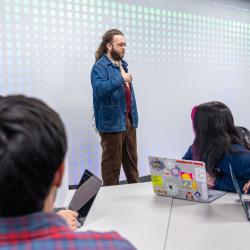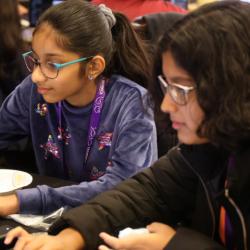Seamlessly Connecting Smart Tech to Our Everyday Lives
Computer Science Ph.D. candidate Nakul Garg was recognized for his innovative contributions to low-power sensing and perception systems, earning a 2024 Marconi Society Award and Cyber-Physical Systems Rising Star Award.
Nakul Garg, a Ph.D. candidate in the University of Maryland’s Department of Computer Science, was honored for his innovative work developing sustainable and intelligent systems for resource-constrained environments, involving innovations in low-power sensing, wireless communication and embedded artificial intelligence (AI).

He recently received a 2024 Cyber-Physical Systems (CPS) Rising Star Award, a program sponsored by the National Science Foundation, the Association for Computing Machinery’s Special Interest Group on Embedded Systems and the University of Virginia. The highly competitive program selected just 36 early-career researchers from a pool of 220 applicants who work on cyber-physical systems, a multidisciplinary field integrating computation, networking and physical processes.
Later this month, Garg will also receive the 2024 Paul Baran Young Scholar Award from the Marconi Society at a ceremony in Bologna, Italy. The award is presented to promising young engineers who have demonstrated technical excellence and leadership in information and communications technology. This year, Garg was among four recipients selected from a competitive global pool to receive the honor.
For Garg, the awards are an affirmation that he’s on the right path to his goal of creating tiny, ultra-efficient intelligent sensors that can be used in a wide range of applications—from microrobots to wearable tech.
“It really means a lot to me, especially because I’m the first person in my family to become a researcher,” he said. “The awards have also given me a chance to connect with many other researchers in the field and gain a broader perspective on how to present my work and its potential impact on society.”
Garg has developed novel sensors that use a hundred times less energy than traditional sensor arrays while also maintaining high-resolution perception. He noted that these sensors can be used on insect-scale robots to monitor precision agriculture and climate change. They can also be built into drones that can locate people after a natural disaster or even installed in mobile phones to fight deepfakes.
Garg’s advisor, Nirupam Roy, an assistant professor of computer science at UMD, believes this recognition of Garg’s work is incredibly well deserved.
“Nakul has done very fine work while at my lab, including developing a tiny GPS-tracker device able to run for five years on just a coin cell battery,” Roy said. “His work really has the potential to impact lives and to make a difference in society.”
Designing a smarter, safer, more sustainable future
Much of Garg’s current research continues to bridge the gap between smart tech and everyday life, with an added emphasis on sustainability and scalability. One project involves creating ultra-efficient perception sensors that allow microrobots to scan a physical environment and navigate through it with ease for search and rescue operations. Garg explained that while self-driving cars use power-hungry lidar and camera systems, tiny search robots need much more compact, energy-efficient solutions.
“Today’s robots can’t just go through debris to locate hurt people or through a forest to find resources,” Garg explained. “I tried to solve that by creating these special acoustic sensors for microrobots. These sensors use 3D-printed structures to capture acoustic data from an environment. This data is then processed using AI to create a map of the terrain, allowing microrobots to navigate the terrain—all at a much lower power consumption rate compared to traditional sensors like lidar and radar.”
Garg and his team in Roy’s lab are also developing ultra-efficient sensors that can be integrated into food packaging to provide real-time data on freshness.
“We’re making radio wave-reliant sensors that can tell you data like how much water or sugar content there is in fresh produce, which in turn helps determine how that food is ripening or spoiling,” he explained. “You just stick it on a food item like lettuce, for example, and it will monitor the food’s freshness.”
This technology could revolutionize food supply chains, allowing for dynamic updates to expiration dates and more efficient distribution.
“If a store like Costco uses this smart packaging and decides that this particular bag of avocados is ripening a little faster than expected, they can reroute it to a different Costco location,” Garg said. “Hopefully, this type of smart tech can help both the store and the consumer prevent costly food waste, which is a growing problem society faces.”
Garg’s experiences at Maryland have inspired him to think more critically about life’s everyday challenges and how he can apply his skills to help improve people’s lives. As he nears the conclusion of his Ph.D. program, Garg is optimistic that he’ll be able to create thoughtfully designed technology that can make a difference in the world.
“Nirupam often says that computer science Ph.D. students aren’t actually getting a degree specifically for computer science,” Garg shared. “A Ph.D. is short for a doctorate of philosophy—it means that the skills and things that I’m learning will also help me be a problem-solver in any field.”







